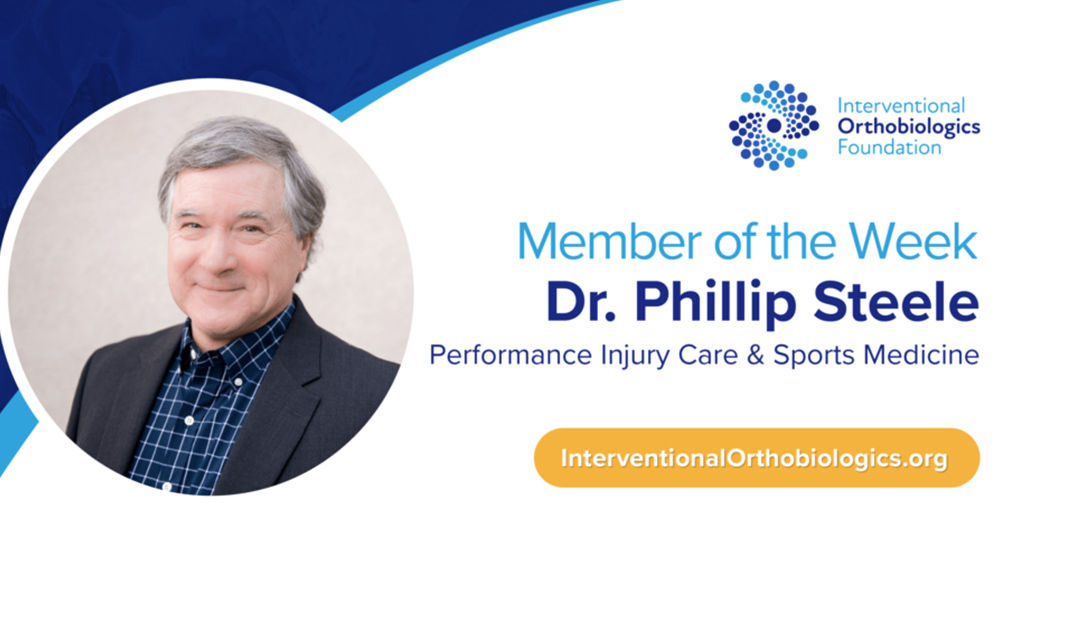Our member of the week blog introduces you to our fellow level members, showcasing their unique work and commitment to IOF. We feature different fellows who have made extraordinary contributions to the field of Interventional Orthopedics.
To be considered for this feature, please email us.
Meet Dr. Phillip Steele
Practice Website: Helenasportsmed.com
Connect with Dr. Steele:
Our next Member of the Week feature takes us to Helena, Montana to meet Dr. Phillip Steele of Performance Injury Care & Sports Medicine, which he founded in 2007.
Dr. Steele is Board Certified in Family Practice and completed an extra year of fellowship training to compete and become certified in sports medicine. In addition, he credentialed in RMSK (Registered Musculoskeletal Ultrasound) and is one of the top musculoskeletal ultrasound experts in the country. He has spoken at numerous medical conferences and is considered as one of the leading national and international experts on the evaluation and treatment of the brachial and cervical plexus using high resolution ultrasound. He has chosen to specialize in non-operative sports medicine and IROM (interventional regenerative orthopedic medicine) to provide many regenerative techniques.
Since his Sports Medicine fellowship, Dr. Steele has worked with the U.S. Ski team, traveling overseas for event coverage for the Nordic Combined and Cross Country Ski Teams. He was an athlete physician at Soldier Hollow Nordic venue during the 2002 Winter Olympics in Salt Lake City and he has worked as a Team Physician for University of Wyoming athletics.
During his eight years in Wyoming, Dr. Steele was integral in developing coaches’ sports medicine education programs for the high school athletes, and he developed a special passion for the education and management of concussion in sports. Since moving to Montana, Dr. Steele has served on the High School Sports Medicine Advisory Committee, and is actively promoting athletic safety for kids in Montana. Also, Dr. Steele has served on the Governor’s task force Montana Youth Concussion Advisory Panel.
Q&A with Dr. Steele
IOF: Who are your biggest mentors in regenerative medicine?
Dr. Steele: This is a great question that has evolved through the trying times of the COVID-19 pandemic. Before the pandemic, my answer would have been different than it is today. With conferences and workshops taking a back seat, I formed a regenerative Zoom group that meets monthly. We have about 20 doctors in the group who gather for short 20-30 minute presentations and then we debate treatment. It’s been a blast and the most productive learning hour of my career each month. We have a wide range of topics we cover and it has totally changed my practice and others in the group.
IOF: What is your best advice for those wanting to get into regenerative medicine?
It’s all about the diagnosis. In regenerative medicine, don’t look just at the source of pain for a patient. Think about the musculoskeletal system and more importantly the neurofascial musculoskeletal system. That’s the beauty of what we can do, not only do we treat the joint but we can also treat what led to the joint breaking down.
IOF: Where do you see the field of regenerative medicine in 5 years?
My hope and dream for regenerative medicine in the future is…. integration of fascia to optimize outcomes. To understand this concept, consider medial compartment knee OA. The beginning of the end for many is degeneration of the lateral intramuscular septum (fascia) of the upper leg. Pelvis control is dependent on the gluteus maximus insertion into the lateral fascial system along with normal quadriceps control. Breakdown to the fascial system creates a valgus motion through the knee and eventually medial knee OA.
What if regenerative medicine not only treats knee OA but also can be used to prevent it down the road? By identifying and treating these critical fascial systems we can hopefully change the paradigm from treating end stage disease to preventing it.
IOF: Tell us about your experience treating nerve entrapments.
Dr. Steele: As a sports medicine physician, I never really thought of myself as a nerve entrapment specialist. More than 10 years ago, I heard a presentation on ultrasound evaluation of nerve entrapments that has led to my passion of identifying the cervical and brachial plexus with ultrasound. With the advent of regenerative medicine, we can now treat and help patients with nerve entrapments to the neck, shoulder and scapula giving them new hope.
IOF: How has IOF impacted you the most?
Dr. Steele: I really appreciate the opportunity to network with other providers after hours and during dinner at the annual conference. Talking about different approaches to patients and practice management with providers that have similar practices to mine is a huge bonus of IOF membership. The conference is always fantastic but being in an environment with other providers that have a focus on orthobiologics is critical to my practice’s success. I alway come back from the IOF conference with new ideas and treatment options.
IOF: Of what are you most proud of?
Dr. Steele: I’ve spent many years focused on the brachial and cervical plexus, along with scapular issues. The opportunity to present my work and lead workshops to my peers has been quite an honor.
IOF: What do you treat most frequently with regenerative medicine?
Dr. Steele: As my practice is very focused on nerve entrapments to the neck and scapula, the most common regenerative procedure is to the brachial plexus, shoulder and scapula region.

